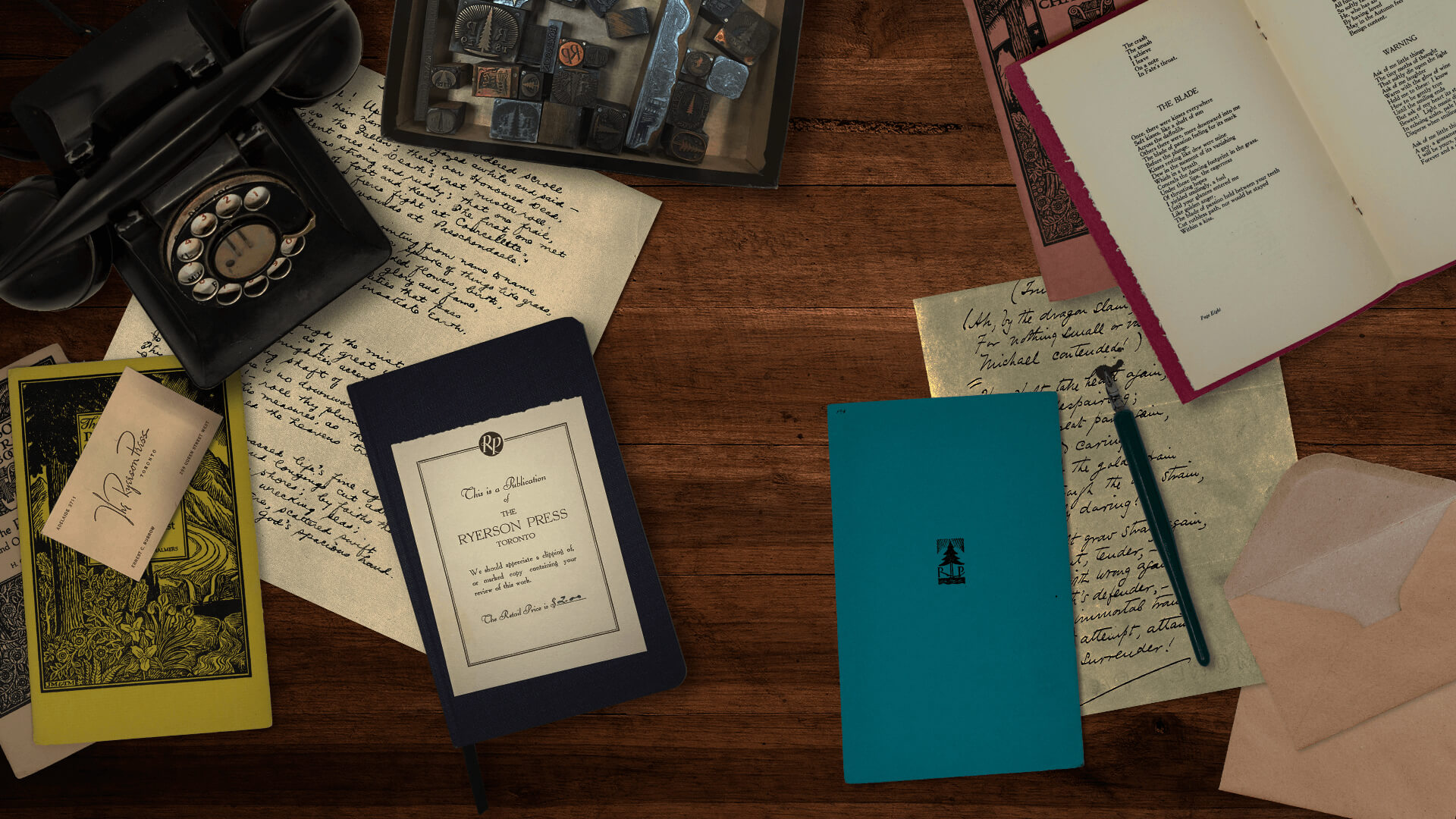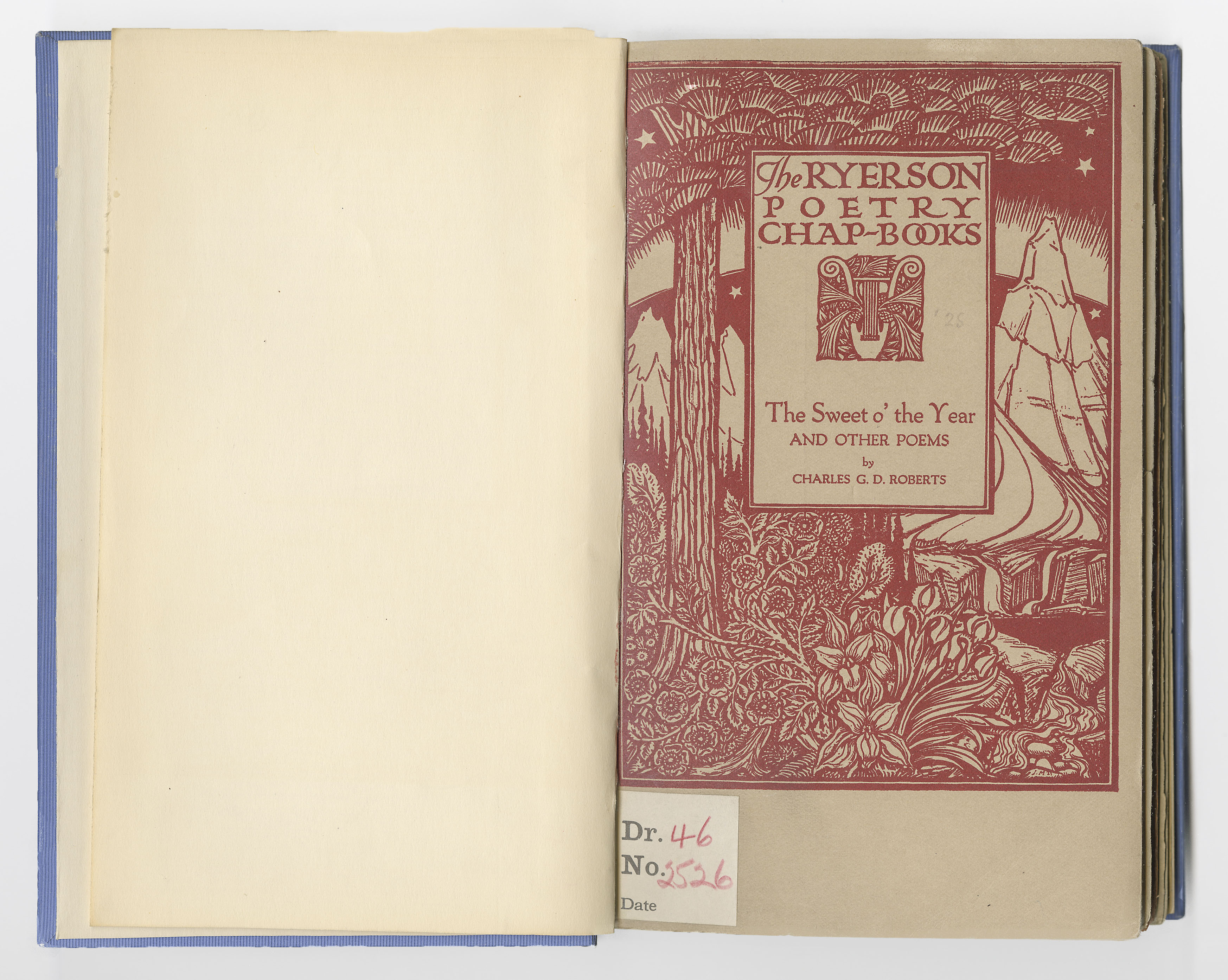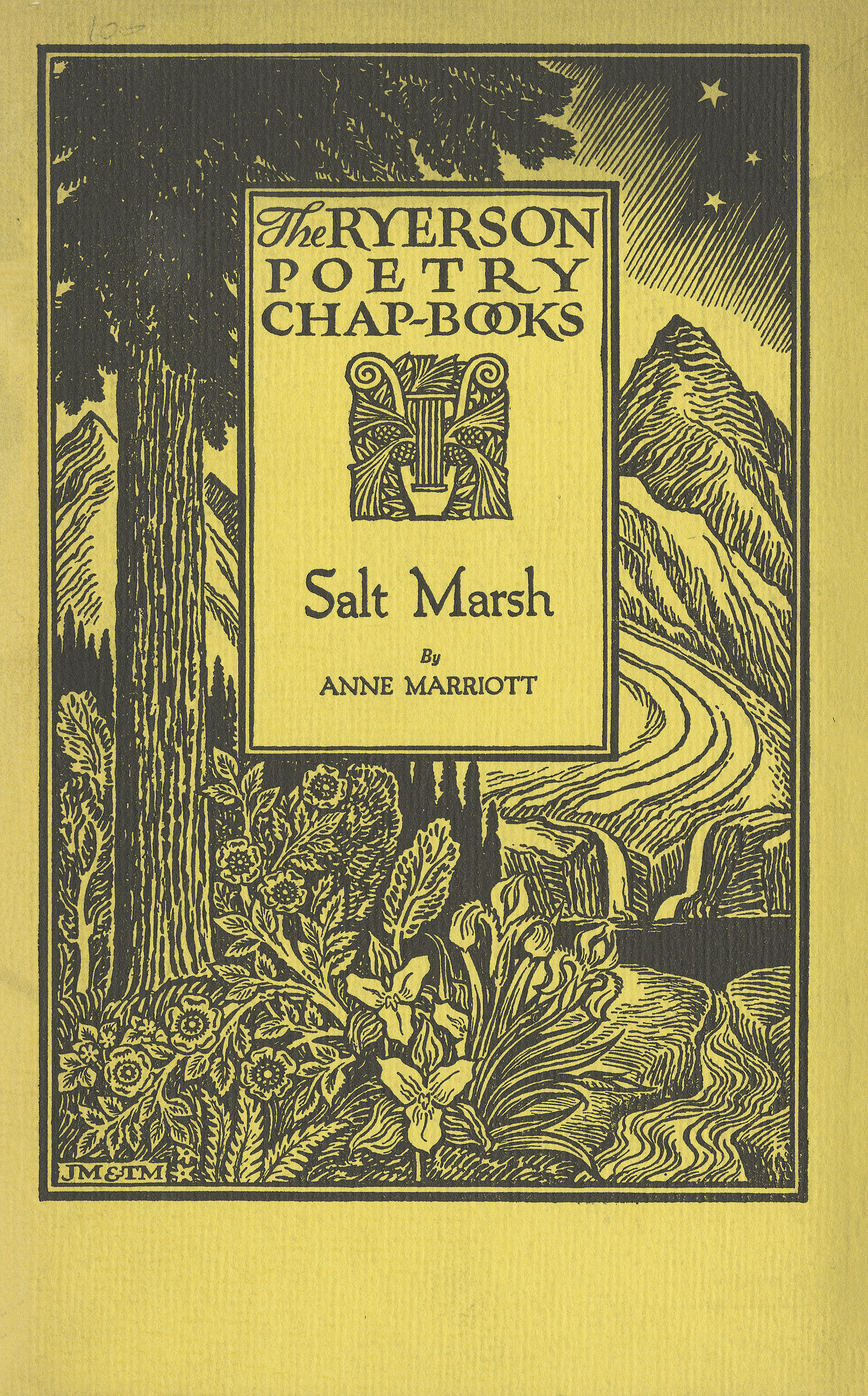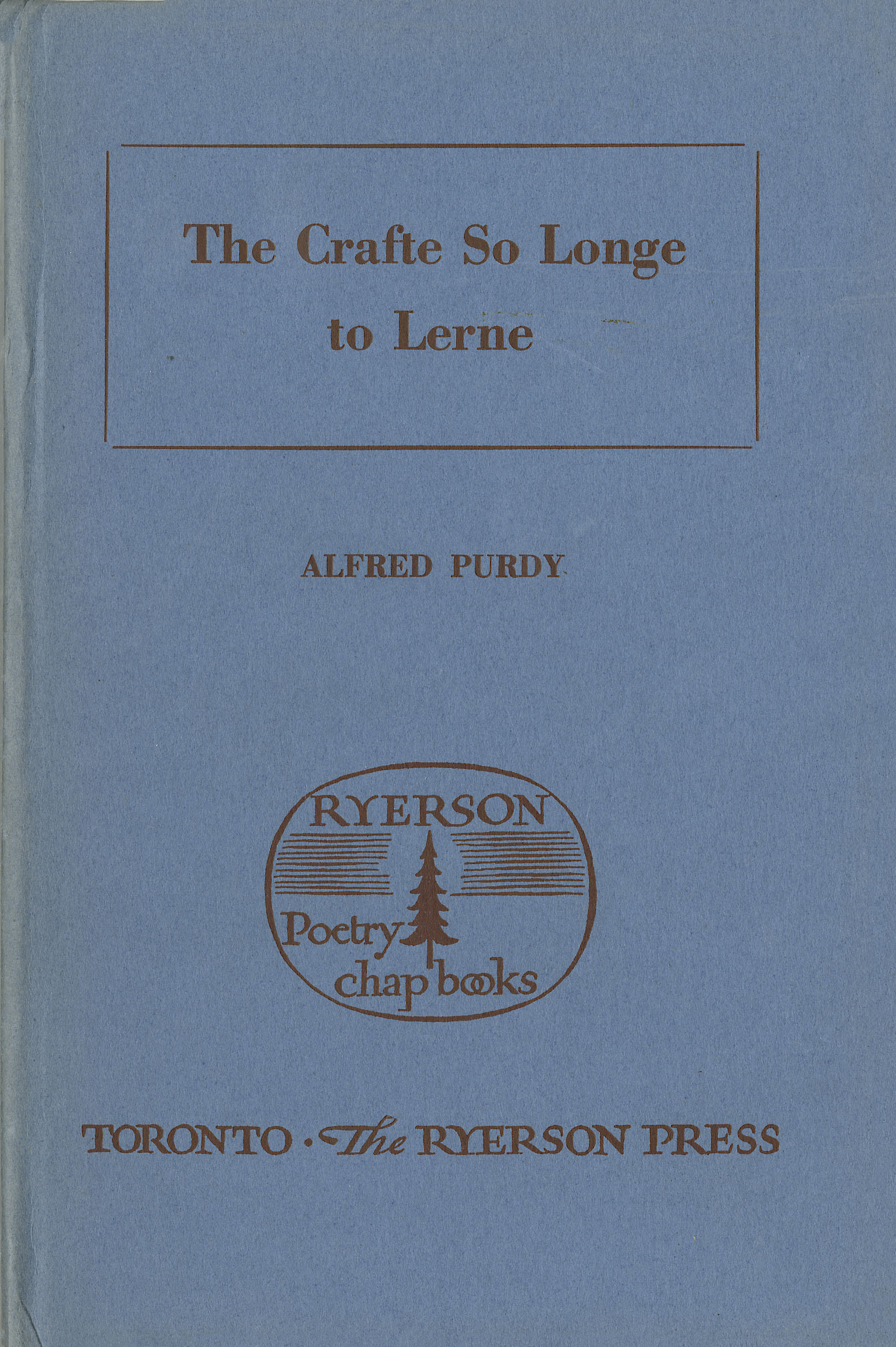The Ryerson Poetry Chap-Books are a series of 200 short books of poetry published by the Ryerson Press between 1925 and 1960, with a final outlier in 1962. In their day, they constituted an unprecedented initiative to publish Canadian poetry in a sustained manner on a national scale. Important poets number among the contributors, such as Charles G.D. Roberts, Dorothy Livesay, Louis Dudek, Elizabeth Brewster, Al Purdy, and Leonard Cohen. Dozens of lesser-known writers were also included. The high number of contributors – 144 – and the persistence of the series across three-and-a-half decades, including some of the most tumultuous years of the twentieth century, make the Chap-Books an important record of the culture of Canadian poetry – of both its aesthetic principles and its material situation and practices – as it existed before government funding of the arts became the norm.
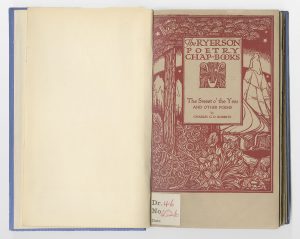
The goal of the editor, Lorne Pierce, was at once to promote and develop the tradition of Canadian poetry. In 1925, this tradition rested squarely with the Confederation Poets, whose prime mover was Roberts, and for this reason the inaugural number, The Sweet o’ the Year and Other Poems (1925), was solicited from him. It was not an original book of new poems but a selection of his prior work. Roberts’s influence drew the series in its early years toward the late-nineteenth-century poetics that had formed him. Many of the Chap-Books through the 1940s consist of poems with full metrical lines, rhyming stanzas, images of nature and local landscapes, and an idealism that offers consolation and dignity in the face of the suffering. Lilian Leveridge’s A Breath of the Woods (1926) is one example of an active inheritance of the Confederation Poets, presenting finely crafted lyrics that strive to uplift and ennoble the average reader through accessible sentiments and recognizable verse forms; Nathaniel A. Benson’s romantic elegy, Twenty and After (1927), is another.
Even with Roberts’s gravity, however, the series also drew into its orbit poems written in response to the two World Wars and the Great Depression, city poems, and formally experimental poems. Free verse on the model of Walt Whitman manifested itself as early as the second Chap-Book, W.H.F. Tenny’s Companionship and the Crowd and Other Poems (1925). Anne Marriott’s The Wind Our Enemy (1939) was partly inspired by T.S. Eliot’s The Waste Land. Louis Dudek’s The Searching Image (1952) clearly announces his admiration for Wallace Stevens and Ezra Pound. Fred Cogswell’s The Testament of Cresseid (1957) is a modern translation of Robert Henryson’s fifteenth-century poem of the same title – a translation remarkable for its ornament and learned impersonality. Consequently, the Chap-Books are a rich and varied illustration, too, of the gradual suffusion of modernist aesthetics through Canadian poetry, especially after 1940.
The overall character of the series is not easily reducible because Pierce was an ecumenical editor. His primary goal was to edit a series that was broad enough in scope and representation to be defensibly national. He strove to reflect the Canada he knew from his childhood, from his student days at Queen’s University, from his formative experiences as a Methodist probationer on the Prairies, and from his cross-country train trips. The Chap-Books thus drew in writers such as Alexander Louis Fraser from Nova Scotia, Dorothy Roberts from New Brunswick, Leo Cox from Quebec, Kathryn Munro from Ontario, Elaine M. Catley from Alberta, and Ernest Fewster from British Columbia. Over half of the contributors were women, a predominance that accurately reflected their majority membership in the branches of the Canadian Authors’ Association. Disabled writers were welcomed into the series, such as Annie Charlotte Dalton, who was deaf. Children were the intended audience of May P. Judge’s The Way to Fairyland and Other Rhymes (1931). Some contributors took as their theme historic injustice against minorities. Livesay, for example, described the internment of Japanese-Canadians during the Second World War in her Call My People Home (1950). Susan Frances Harrison portrayed rural, francophone Quebec sympathetically in Later Poems and New Villanelles (1928). In his long poem, Paul Pero (1928), R.D. Cumming narrated a Lillooet (St’át’imc) chief’s tragic struggle for justice after the death of his wife at the hands of a white man. Pierce was open to all kinds of poetry, so long as it reflected some aspect of Canadian experience – even emigration to the United States, as in Arthur Stringer’s New York Nocturnes (1948). Overall, the editorial vision for the series was inclusive.

Bibliographically, the Chap-Books embody leanness and austerity but also an insistence on the value of poetry. Financing production was a difficulty from the outset, so Pierce developed a policy in which the author contractually promised to reimburse the press for the cost of printing if, after a year, an edition had failed to sell. This guarantee ranged between $55 and $185 and averaged $93. True to their etymology, the Chap-Books are cheap books: most consist of a single printed sheet folded into as few as eight pages, stapled into a coloured paper cover that doubles as the title-page. The typography is compact, with ten lines of type measuring only 35 mm vertically, capital letters being 2.6 mm tall and lowercase ones (x-height) 1.5 mm. Pierce commissioned a woodcut from Group of Seven member J.E.H. MacDonald, which declares the nationalism of the series in a northern scene featuring a rocky river, a glacier-fed lake, mountains, and an arch of the northern lights. In the foreground cluster the provincial flowers of Nova Scotia (trailing arbutus), Quebec (lilies), Ontario (trilliums), Alberta (wild roses), and British Columbia (Pacific dogwoods). At the centre, pine branches emanate from a lyre, symbolizing the importance of poetry in the building of a nation. Pierce maintained this design, and the series itself, through the 1930s, when production plummeted from a high of thirteen new titles a year (1927) to only one (1933). Most Chap-Books were printed in a run of 250 copies and sold for between fifty cents and one dollar, depending on the outlay of paper. Occasionally, an ambitious author would raise the total to as many as 500 copies. Such authors made work for themselves, however, in so far as the responsibility for selling copies was often left to them.

Thoreau MacDonald renewed his father’s design in 1942 for Mary Elizabeth Colman’s For This Freedom Too and subsequent numbers. By this time authors were no longer being asked to guarantee the press against loss. After an experiment in paying authors a royalty of ten per cent, Pierce settled on terms that offered the author sixty, thirty, and finally only eighteen complimentary copies in lieu of all royalty. The MacDonald woodcut was dropped with Arthur Bourinot’s The Treasures of the Snow (1950) but reinstated with William Sherwood Fox’s On Friendship (1953), which was also the first to have a hardcover binding (still paper, not cloth) and a proper title page. Myrtle Reynolds Adams’s Remember Together (1955), neatly stating title, author, city, and publisher, defined the look of the Chap-Books through the flurry of activity that characterized their last years, when as many as ten new titles again appeared annually (1959). Only the very last numbers had their titles printed on the spine, making them visible on a shelf, and right to the end paper was conserved through the printing of more than one poem per page. The type remained as small as before, but the leading (the spacing between the lines) became more generous, with ten lines of type now measuring 43 mm vertically.
All of these details indicate parsimony in physical production, but also the will to persevere as a publisher of poetry no matter the odds. In Pierce’s own words, from the series advertisement on the inside back cover of the first numbers, “The Ryerson Press believes that lovers of poetry care more for poetry of high quality than for costly bindings … A chap-book necessitates careful discrimination by the poet, and hence the presentation of small and choice selections.” It was Pierce’s desire to hold to a modicum of elegance in even the most adverse times, and he did so.1
List of the Ryerson Poetry Chap-Books
Note on the numbering: The first Chap-Book to have a series number printed on the inside front cover was Lilian Leveridge’s The Blossom Trail (1932) (no. 57). The Ryerson Press made a retrospective effort to number the prior Chap-Books, and that numbering is given below in parentheses, but some errors occurred in the process. (For example, H.T.J. Coleman’s Cockle Shell and Sandal Shoon was published in 1927, not 1928.) The series has been re-ordered by observing the publication year in the copyright statement of each Chap-Book and by collating the series advertisements inside the back cover. The revised numbering is given in square brackets.
1925
[1] (RP 1) Charles G.D. Roberts, The Sweet o’ the Year and Other Poems
[2] (RP 2) W.H.F. Tenny, Companionship and the Crowd and Other Poems
1926
[3] (RP 3) Kathryn Munro, Forfeit and Other Poems
[4] (RP 4) Constance Davies-Woodrow, The Captive Gypsy
[5] (RP 5) Annie C. Dalton, The Ear Trumpet
[6] (RP 6) W.V. Newson, The Vale of Luxor
[7] (RP 7) Theodore Goodridge Roberts, The Lost Shipmate
[8] (RP 9) Lionel Stevenson, A Pool of Stars
[9] (RP 10) Alice Brewer, Spring in Savary
[10] (RP 12) Leo Cox, Sheep-Fold
[11] (RP 8) Geoffrey B. Riddehough, The Prophet’s Man
[12] (RP 13) Agnes Joynes, The Shepherd of the Hills
[13] (RP 18) Lilian Leveridge, A Breath of the Woods
1927
[14] (RP 14) Frederick B. Watt, Vagrant
[15] (RP 11) John Hanlon [Mitchell], Songs
[16] (RP 15) Geoffrey Warburton Cox, What-Nots
[17] (RP 26) Nathaniel A. Benson, Twenty and After
[18] (RP 17) Alexander Louis Fraser, By Cobequid Bay
[19] (RP 20) Guy Mason, The Cry of Insurgent Youth
[20] (RP 32) H.T.J. Coleman, Cockle-Shell and Sandal-Shoon
[21] (RP 22) Esme Isles-Brown, Twelve Poems
[22] (RP 23) [Dorothy] Gostwick Roberts, Songs for Swift Feet
[23] (RP 19) Elaine M. Catley, Ecstasy and Other Poems
[24] (RP 16) John Hanlon [Mitchell], Other Songs
[25] (RP 21) W.V. Newson, Waifs of the Mind
[26] (RP 24) William P. McKenzie, Bits o’ Verse in Scots
1928
[27] (RP 25) Mary Matheson, Destiny and Other Poems
[28] (RP 27) H.T.J. Coleman, The Poet Confides
[29] (RP 28) R.D. Cumming, Paul Pero
[30] (RP 29) Kate Colquhoun, The Battle of St. Julien and Other Poems
[31] (RP 35) William P. McKenzie, Fowls o’ the Air and Other Verses in Scots
[32] (RP 33) Susan Frances Harrison, Later Poems and New Villanelles
[33] (RP 30) Guy Mason, Spendthrifts
[34] (RP 31) Thomas O’Hagan, The Tide of Love
[35] (RP 34) Nelda MacKinnon Sage, Fragments of Fantasy
1929
[36] (RP 39) F. Elsie [Elsie Fry] Laurence, XII Poems
[37] (RP 36) Regis [R.M. Whylock], Cosmic Oratory
[38] (RP 37) Winifred Stevens, The Viking’s Bride
[39] (RP 38) May P. Judge, The Blue-Walled Valley
[40] (RP 41) H.L. Huxtable, The Fountain: A Dramatic Fantasy
[41] (RP 42) Jean Kilby Rorison, In My Garden
[42] (RP 40) Marie Zibeth [Mary Elizabeth] Colman, The Immigrants
[43] (RP 44) Mary Matheson, Magic Hill and Other Poems
[44] (RP 43) John Hosie, The Arbutus Tree and Other Poems
[44B] Carillon Group of the Writers’ Craft Club, A Sheaf of Verse
1930
[45] (RP 45) William Edwin Collin, Monserrat and Other Poems
[46] (RP 47) Elsie Woodley, Bittersweet
[47] (RP 46) William P. McKenzie, The Auld Fowk
[48] (RP 49) Nathaniel A. Benson, The Wanderer and Other Poems
[49] (RP 48) Edith Beatrice Henderson, Outward Bound
[50] (RP 50) Kathryn Munro, Under the Maple
[51] (RP 51) Alfred Goldsworthy Bailey, Tâo
1931
[52] (RP 53) May P. Judge, The Way to Fairyland and Other Rhymes
[53] (RP 54) Mary Ellen Guise, Pennies On My Palm
[54] (RP 55) Aubrey Dean Hughes, Argosies at Dawn
[55] (RP 52) Marjorie Pickthall, The Naiad, and Five Other Poems
[55B] Ann Boyd, Spring Magic
[83] Bliss Carman, The Music of Earth
1932
[56] (RP 56) Lionel Stevenson, The Rose of the Sea
57 Lilian Leveridge, The Blossom Trail
58 Francis Cecil Whitehouse, The Coquihalla Wreck and Other Poems
59 Leo Cox, The Wind in the Field
60 Sister Maura, Rhyme and Rhythm
61 Muriel Miller Humphrey, Twenty Sonnets
62 Clara Hopper, The Emigrants’ Stone and Other Poems
63 Audrey Silcox, Earthbound and Other Poems
64 E.H. Burr, Rich Man, Poor Man
65 Regina Lenore Shoolman, Uncertain Glory
66 George Frederick Clarke, The Saint John and Other Poems
1933
67 Murdock Charles Mackinnon, From the Winepress
1934
68 Marion E. Moodie, Songs of the West and Other Poems
1935
69 Frances Ebbs-Canavan, Harvest of Dreams
70 Agnes Maule Machar, The Thousand Islands
71 Peggy Pearce, Wayside Grasses
1936
72 William Thow, Odd Measures
[73] Joseph Easton McDougall, Blind Fiddler
1937
74 William Thow, More Odd Measures
75 Leo Cox, River Without End
76 Charles Frederick Boyle, Stars before the Wind
77 Helena Coleman, Songs: Being a Selection of Earlier Sonnets and Lyrics
1938
78 Michael T. Casey, Sonnets and Sequence
79 John Smalacombe [L.A. MacKay], Viper’s Bugloss
1939
80 Anne Marriott, The Wind Our Enemy
81 Isobel McFadden, Reward and Other Poems
82 Lilian Leveridge, Lyrics and Sonnets
[83] (see 1931)
84 Charles Frederick Boyle, Excuse for Futility
85 Carol Coates, Fancy Free
86 William Thow, Poet and Salesman
1940
87 Arthur S. Bourinot, Discovery
88 H. Glynn-Ward, The Pioneers and Other Poems
1941
89 Anne Marriott, Calling Adventurers!
90 Mary Matheson, Out of the Dusk
91 Nathan Ralph, Twelve Poems
92 Sara Carsley, The Artisan
93 Doris Ferne, Ebb Tide
94 Mollie Morant, The Singing Gipsy
95 Amelia Wensley, At Summer’s End
1942
96 Ernest Fewster, Litany before the Dawn of Fire
97 Barbara Villy Cormack, Seedtime and Harvest
98 Hyman Edelstein, Spirit of Israel
99 Mary Elizabeth Colman, For This Freedom Too
100 Anne Marriott, Salt Marsh
1943
101 Evelyn Eaton, Birds before Dawn
102 M. Eugenie Perry, Hearing a Far Call
103 Irene Chapman Benson, Journey into Yesterday
1944
104 Elsie Fry Laurence, Rearguard and Other Poems
105 Gwendolen Merrin, Legend and Other Poems
106 Frank Oliver Call, Sonnets for Youth
107 Austin Campbell, They Shall Build Anew
108 Sister Maura, Rhythm Poems
1945
109 Hermia Harris Fraser, Songs of the Western Islands
110 Monica Roberts Chalmers, And in the Time of Harvest
111 Eileen Cameron Henry, Sea-Woman and Other Poems
112 Vere Jameson, Moths after Midnight
113 Dorothy Howard, When I Turn Home
1946
114 Margot Osborn, Frosty-Moon and Other Poems
115 R.E. Rashley, Voyageur and Other Poems
116 George Whalley, Poems: 1939–1944
117 Marjorie Freeman Campbell, Merry-Go-Round
118 Verna Loveday Harden, When This Tide Ebbs
119 Norah Godfrey, Cavalcade
120 Audrey Alexandra Brown, V-E Day
121 Doris Hedges, The Flower in the Dusk
122 Goodridge MacDonald, The Dying General and Other Poems
1947
123 M. Eugenie Perry, Song in the Silence and Other Poems
124 Michael Harrington, The Sea Is Our Doorway
125 Doris Hedges, Crisis
126 Dorothy Howard, As the River Runs
127 Ruby Nichols, Songs from Then and Now
1948
128 Lenore Pratt, Midwinter Thaw
129 Genevieve Bartole, Figure in the Rain
130 Margaret E. Coulby, The Bitter Fruit and Other Poems
131 Albert Norman Levine, Myssium
132 John A.B. McLeish, Not Without Beauty
[133] (RP 132) Arthur Stringer, New York Nocturnes
1949
134 Marjorie Freeman Campbell, High on a Hill
[135] (RP 136) Hyman Edelstein, Last Mathematician
136 Thomas Saunders, Scrub Oak
137 John Murray Gibbon, Canadian Cadences
1950
138 Goodridge MacDonald, Beggar Makes Music
139 Kathryn Munro, Tanager Feather
140 Arthur S. Bourinot, The Treasures of the Snow
141 Geoffrey Drayton, Three Meridians
142 Katherine Hale, The Flute and Other Poems
143 Dorothy Livesay, Call My People Home
1951
144 Theresa E. Thomson, Silver Shadows
145 Elizabeth Brewster, East Coast
146 Raymond Souster, City Hall Street
1952
147 Louis Dudek, The Searching Image
148 Tom Farley, It Was a Plane
149 Ruth Cleaves Hazelton, Mint and Willow
150 Myra Lazechko-Haas, Viewpoint
1953
151 R.E. Rashley, Portrait and Other Poems
152 William Sherwood Fox, On Friendship
1954
153 Elizabeth Brewster, Lillooet
154 Anthony John Frisch, Poems
155 Arthur S. Bourinot, Tom Thomson and Other Poems
1955
156 I. Sutherland Groom, Queens and Others
157 Alfred W. Purdy, Pressed on Sand
158 Goodridge MacDonald, Compass Reading and Others
159 Theresa E. and Don W. Thomson, Silver Light
160 A. Robert Rogers, The White Monument
161 Thecla Jean Bradshaw, Mobiles
162 Myrtle Reynolds Adams, Remember Together
1956
163 Marion Kathleen Henry, Centaurs of the Wind
164 Fred Cogswell, The Haloed Tree
165 Freda Newton Bunner, Orphan and Other Poems
166 Ruby Nichols, Symphony
167 Lenore A. Pratt, Birch Light
1957
168 Fred Cogswell, trans., The Testament of Cresseid, by Robert Henryson
169 Hermia Harris Fraser, The Arrow-Maker’s Daughter and Other Haida Chants
170 Goodridge MacDonald, Recent Poems
171 Theresa E. and Don W. Thomson, Myth and Monument
172 Joan Finnigan, Through the Glass, Darkly
173 Mary Elizabeth Bayer, Of Diverse Things
174 Elizabeth Brewster, Roads and Other Poems
175 Dorothy Roberts, Dazzle
176 Ella Julia Reynolds, Samson in Hades
1958
177 Myrtle Reynolds Adams, Morning on My Street
178 John Heath, Aphrodite
179 Thomas Saunders, Something of a Young World’s Dying
180 Fred Swayze, And See Penelope Plain
1959
181 Mary Elizabeth Bayer, Faces of Love
182 Michael Collie, Poems
183 Verna Loveday Harden, In Her Mind Carrying
184 Douglas Lochhead, The Heart Is Fire
185 Theresa E. and Don. W. Thomson, River & Realm
186 Alfred Purdy, The Crafte So Longe to Lerne
187 R.E. Rashley, Moon Lake and Other Poems
188 Florence Wyle, Poems
189 John Robert Colombo, ed., The Varsity Chapbook
190 Leslie L. Kaye, ed., The McGill Chapbook
1960
191 Douglas Lochhead, It Is All Around
192 Michael Collie, Skirmish with Fact
193 William Conklin, For the Infinite
[194] (RP 195) Paul West, The Spellbound Horses
195 Mary Nasmyth Matheson, Autumn Affluence
196 Fred Swayze, In the Egyptian Gallery
197 Myrtle Reynolds Adams, To Any Spring
198 Mary Elizabeth Bayer, The Silver Swan: An Epithalamion
199 Milton Acorn, The Brain’s the Target
1962
200 James Reaney, Twelve Letters to a Small Town
1 For more information on the Ryerson Poetry Chap-Books, see Sandra Campbell, Both Hands: A Life of Lorne Pierce of Ryerson Press (Montreal/Kingston: McGill-Queen’s UP, 2013); Eli MacLaren, “‘Significant Little Offerings’: The Origin of the Ryerson Poetry Chap-Books, 1925-26,” Canadian Poetry: Studies, Documents, Reviews 72 (2013): 9-49; and Eli MacLaren, Little Resilience: The Ryerson Poetry Chap-Books (Montreal/Kingston: McGill-Queen’s UP, forthcoming 2020).
